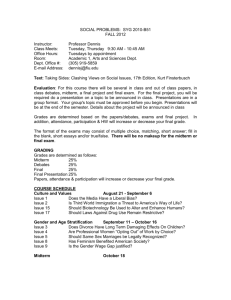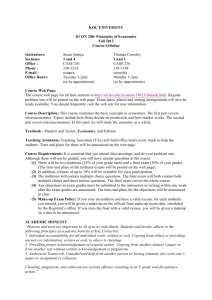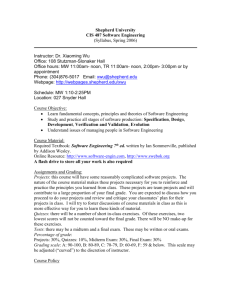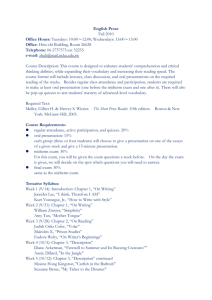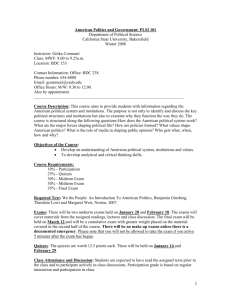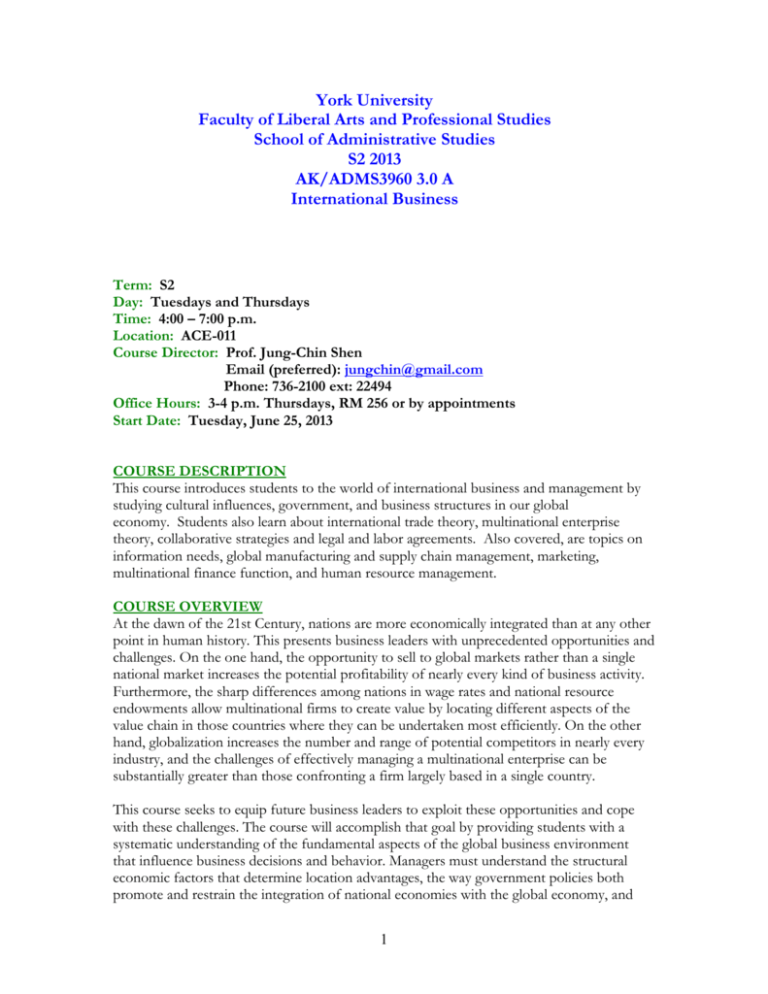
York University
Faculty of Liberal Arts and Professional Studies
School of Administrative Studies
S2 2013
AK/ADMS3960 3.0 A
International Business
Term: S2
Day: Tuesdays and Thursdays
Time: 4:00 – 7:00 p.m.
Location: ACE-011
Course Director: Prof. Jung-Chin Shen
Email (preferred): jungchin@gmail.com
Phone: 736-2100 ext: 22494
Office Hours: 3-4 p.m. Thursdays, RM 256 or by appointments
Start Date: Tuesday, June 25, 2013
COURSE DESCRIPTION
This course introduces students to the world of international business and management by
studying cultural influences, government, and business structures in our global
economy. Students also learn about international trade theory, multinational enterprise
theory, collaborative strategies and legal and labor agreements. Also covered, are topics on
information needs, global manufacturing and supply chain management, marketing,
multinational finance function, and human resource management.
COURSE OVERVIEW
At the dawn of the 21st Century, nations are more economically integrated than at any other
point in human history. This presents business leaders with unprecedented opportunities and
challenges. On the one hand, the opportunity to sell to global markets rather than a single
national market increases the potential profitability of nearly every kind of business activity.
Furthermore, the sharp differences among nations in wage rates and national resource
endowments allow multinational firms to create value by locating different aspects of the
value chain in those countries where they can be undertaken most efficiently. On the other
hand, globalization increases the number and range of potential competitors in nearly every
industry, and the challenges of effectively managing a multinational enterprise can be
substantially greater than those confronting a firm largely based in a single country.
This course seeks to equip future business leaders to exploit these opportunities and cope
with these challenges. The course will accomplish that goal by providing students with a
systematic understanding of the fundamental aspects of the global business environment
that influence business decisions and behavior. Managers must understand the structural
economic factors that determine location advantages, the way government policies both
promote and restrain the integration of national economies with the global economy, and
1
the impact of volatility in the global macroeconomic environment on international business
strategy. These issues will be studied using the analytical tools and concepts of international
economics, and case studies will be used to relate these concepts to actual business
problems.
In addition to learning about strategic concepts, you can expect to further develop your
abilities in sizing up complex business situations and identifying the core problems or issues.
You will have the opportunity to analyze qualitative and quantitative data, both internal and
external to the firm, and assessing what implications it may hold for a firm's success.
REQUIRED TEXT(S)
Daniels, J. D., Radebaugh, L. H., & Sullivan, D. P., International Business: Environments and
Operations, 14th Edition, Pearson Prentice Hall, 2012.
Recommended readings:
The Economist; Fortune; Harvard Business Review; Sloan Management Review; California
Management Review; Globe and Mail; Toronto Star.
COURSE EVALUATION
Midterm Exam: 30%
Group Work: 50%
Group report: 25%
Group presentation: 25%
Final Exam: 20%
FORMAT OF THE COURSE
Each session is of a three-hour duration. In the early stage of the course, the role of the
instructor is as a lecturer to help students make sense of the material. As the time goes by,
the role of the instructor will shift to facilitate class discussions. This is a highly interactive
course in which students are required to participate in all class activities and exercises.
Finally, there is a particular format required for each assignment. Any violation of the format
will potentially lead you to fail the assignment. You can buy the cases for individual
assignment and group assignment from the York bookstore.
MIDTERM EXAM
The midterm exam is weighted 30% of your final grade. The exam consists of multiple
choices and short answer questions. The date for the midterm exam can be found in the
course outline below, and will be announced in the course website. The boundary of the
exam includes both the textbook and my lectures. More details will be announced in the
course website.
GROUP WORK
This course puts great emphasis on group work (50%) since group work is a contemporary
work design in the real business world. Accordingly, students will form 8 groups with each
2
group of 6 to 8 members (names of group members are to be submitted no later than July
2). Please be advised that each group member is responsible for the group process and
dynamics. Instructor will not become involved in group issues unless it is necessary. In
addition, students are not allowed to switch groups after group formation.
The purpose of this group presentation is to help students to develop case analysis and
presentation skills. Each group will be assigned one case from the instructor on Week 4.
Each group, acting as a consulting team, will do the case analysis over two weeks. On Week
5 and 6, each group will do a 30-minute presentation (20-minute presentation and 10-minute
Q&As) to other groups who are assigned the other case. There is no required format for the
presentations. Clarity and creativity are keys. As you are assigned to a case, your analysis
should be limited to the case materials. No additional research is necessary nor
recommended. The group written report is limited to 10 pages (including cover page and
appendix), double-spaced, in a 12-point font, Times New Roman. On the cover page, you
have to include the following information: the case title, course section, group number, and
each group member’s name and student number. Name and student number omission is not
allowed. All group written reports are due on July 25.
Words for the Presenting Groups
Your presentation can be as creative as you want. In the presentation, you basically need to
cover the following topics.
1.
2.
3.
4.
Issue identification (what are the issues)
Issue analysis (why those are issues)
Recommendations/Solutions
Implementation/Action
There is no limit on the number of presenters. Please let me know in advance if you need
any equipment assistance. It is recommended that the presenting groups email the instructor
the presentation outlines a day before the presentations.
Words for Audience
To be a good audience, you need to listen to the presentation closely and read the case
material in advance. By doing so, you will find that you can learn a great deal from the
presenting groups. You will be invited to ask any questions you may have. Keep in mind that
your questions need to be constructive and relevant to the presentation and course materials.
FINAL EXAM
The final exam is weighted 30% of your final grade. The exam consists of multiple choices
and short answer questions. The date for the midterm exam can be found in the course
outline below, and will be announced in the course website. The boundary of the exam
includes both the textbook and my lectures. More details will be announced in the course
website.
3
COURSE OUTLINE
Introduction
Week 1
June 25
Chapter 1: Globalization and International Business
What international business is about
Modes of international business
External influences and internal operations
Course Expectation
Administrative issues
Week 1
June 27
Chapter 6: International Trade and Factor Mobility Theory
Comparative advantage and specialization
Factor-proportions theory
The product life cycle theory of trade
Country-similarity theory
The Porter’s diamond model
Factor mobility and its limitations
Internationalization theory
Week 2
July 2
Chapter 2: The Cultural Environments Facing Business
What is culture? Why is culture important for international
business?
What are the roles that culture plays in international business?
Strategies for dealing with cultural differences?
Chapter 3: The Political and Legal Environments Facing Business
Chapter 5: Globalization and Society
The impact of FDI
The impact of MNE
Business ethics
Week 2
July 4
Chapter 7: Government Influence on Trade
Economic rationales for government intervention
Noneconomic rationales for government intervention
Instruments for trade control
Chapter 8: Cross-National Cooperative and Agreements
The trend of regional economic integration
What are the rationales for the regional economic integration?
How to deal with the trend?
Week 3
July 9
Chapter 9: Global Foreign Exchange and Capital Markets
Characteristics of the foreign-exchange market
4
Major foreign-exchange instruments
Chapter 10: The Determination of Exchange Rate
International monetary system
The Determination of Exchange Rate
Exchange-rate and business decisions
Week 3
July 11
Week 4
July 16
Midterm Exam
It will be a close-book, 3-hour exam.
Chapter 11: The Strategy of International Business
Industry, strategy and firm performance
Geography
Global integration versus local responsiveness
Chapter 13: Export and Import Strategies
Export strategies
Import strategies
Third-party intermediaries
Exporting financing
Group case assignment
Week 4
July 18
Chapter 14: Direct Investment and Collaborative Strategies
Motives and modes for collaborative agreements
Managing international agreements
Time for group work
Week 5
July 22
Chapter 15: The Organization of International Business
Organization in the international business
Organizational structure
Coordination and control system
The role of legal structure
Time for group work
Week 5
July 25
Submission of Group Written Reports
Group Presentation I
Week 6
July 30
Group presentation II
Case analysis
Week 6
August 1
Final Exam
5
It will be a close-book, 3-hour exam.
6




